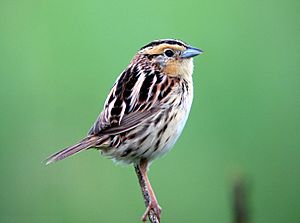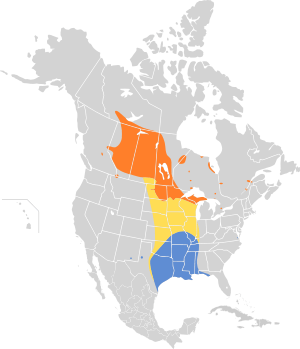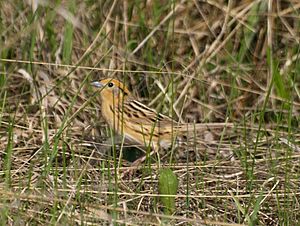LeConte's sparrow facts for kids
Quick facts for kids LeConte's sparrow |
|
|---|---|
 |
|
| Conservation status | |
| Scientific classification | |
| Genus: |
Ammospiza
|
| Species: |
leconteii
|
 |
|
The LeConte's sparrow (Ammospiza leconteii) is one of the smallest New World sparrows in North America.
This bird is very shy. It likes to stay hidden on the ground. It hides under tall grasses. It's hard to make them fly. They often run away instead. When they do fly, they stay low. They usually fly only a foot or two above the grass. Then they land again quickly.
Because they are so hard to see, we don't know much about them. Their nests are also very hard to find. People usually know they are around by hearing their calls. It's rare to actually see one.
Contents
What Does the LeConte's Sparrow Look Like?
The LeConte's sparrow is a small bird. It has a fairly large head. Its bill is short and grey. Its tail is short and pointed.
Its face is a yellow-orange color. It has grey cheeks. The top of its head is dark brown. It has a white stripe down the middle. The back of its neck is lilac grey. It has chestnut streaks there. Its back is streaked with brown and beige. Its belly is off-white. Its chest and sides are a buffy orange-yellow. They have dark brown streaks. Its feet and legs are brownish-pink.
Size and Weight
Here are the average measurements for both male and female LeConte's sparrows:
- Length: 4.7 inches (12 cm)
- Wingspan: 7.1 inches (18 cm)
- Weight: 0.4-0.6 ounces (12-16 g)
Birds That Look Similar
The LeConte's sparrow is often confused with other sparrows. These include:
Once, in June 1949, a LeConte's sparrow and a Nelson's sparrow had babies together. This is called a hybrid. It happened in Ontario, Canada.
Understanding LeConte's Sparrow Classification
The LeConte's sparrow belongs to the group called order Passeriformes. These are often called perching birds. You might also hear them called songbirds.
It is part of the family Passerellidae. Birds in this family are usually small. They have bills that are good for eating seeds.
In the past, the LeConte's sparrow was in a different group. Scientists studied their genes. They found that the old group needed to be split up. Now, this sparrow is in the genus Ammospiza. This group includes other sparrows. They all like to stay on the ground. They prefer tall, thick grasses. They don't usually perch on trees.
The famous bird artist John James Audubon discovered the LeConte's sparrow. He named it after a friend, Doctor LeConte. Most people think he meant John Lawrence LeConte. He was a doctor. But some think he meant John Lawrence's cousin, who was also a doctor.
Where LeConte's Sparrows Live
Geographic Range
LeConte's sparrows have their babies in certain areas. These areas include northeastern British Columbia. They also live across Alberta, Saskatchewan, and southern Manitoba in Canada. In the United States, they are found in central Ontario and Quebec. They go as far south as northern Michigan, Montana, and Minnesota.
In winter, they fly south. They spend winter in the southeastern United States. They go as far west as central Texas. They can be found as far north as central Illinois and Missouri.
Preferred Habitat
LeConte's sparrows like moist, open grassy areas. They need enough plants to hide in. They live in places like meadows, fields, and old crop fields. They also like shallow marshy areas. Sometimes they live in prairies. You might find them near fens or lake-shores in boreal forests.
Studies show that the types of plants matter most. They are more important than climate or how big an area is. These birds are found most often where there is "moderate amounts of bare ground." This means some open dirt mixed with plants.
Farming and draining wet areas are big threats to these sparrows. These activities destroy their homes.
LeConte's Sparrow Behavior
Sounds and Songs
The male LeConte's sparrow has a special song. It sounds like a grasshopper buzzing. It starts with a short squeaky note. Then comes the long buzz. It ends with a short chirp. People often describe it as tika-zzzzzzzzzzzz-tik. Its regular call is a short tsip.
Its song is often confused with the Nelson's sparrow's song. The male usually sings while hidden. But sometimes you can see him singing from a tall grass stem. Or even while flying!
What They Eat
In the summer, LeConte's sparrows mostly eat insects. They munch on weevils, leafhoppers, and leaf beetles. They also eat stinkbugs, caterpillars, moths, and spiders.
In winter, their main food is seeds. They eat seeds from different grasses and weeds. Some examples are northern dropseed, Indian grass, yellow foxtail, panic-grass, scorpion-grass, little bluestem, and big bluestem.
Reproduction and Life Cycle
LeConte's sparrows start to mate in late April. But most mating happens in mid-May. Males sing from thick grasses. They also sing from tall grass stems or in flight.
Females usually lay two to six eggs. Four eggs are most common. Only the female bird sits on the eggs. This is called incubation. It lasts about 11–13 days. Both parents help feed the baby birds.
The babies are born without many feathers. They are called hatchlings. They have dull brown downy patches. They can't do much for themselves at first. A pair of sparrows might have one or two groups of babies each year. We don't know much about the time between hatching and when the babies can fly. This is because the birds are so secretive.
Building a Nest
The female sparrow builds the nest. It is shaped like a cup. She uses fine grasses to build it. She lines it with soft grass and hair. Nests are usually attached to standing grasses or sedges. They are built on or very close to the ground.
LeConte's Sparrow Eggs
The eggs are about 18 X 14 mm long. They are shaped like an oval. The eggs are white. They might have hints of green, grey, or blue. They are covered in tiny brown dots, speckles, or spots. These marks are usually grouped near the larger end of the egg.
Cool Facts About LeConte's Sparrows
- Sometimes, brown-headed cowbirds lay their eggs in LeConte's sparrow nests. This is a type of parasitism. The cowbird babies are then raised by the sparrows.
- This bird is also known as LeConte's Bunting.
- They used to be called "stink birds." This was because hunting dogs often chose them over quail.
- You are much more likely to hear them than see them. One study found 86 male LeConte's sparrows by sound. But only 8 of those males were actually seen!
- Very few LeConte's sparrows have ever been banded. Banding helps scientists track birds. Between 1967 and 1984, only 355 were banded. None of them were ever caught again.
See also
 In Spanish: Ammodramus leconteii para niños
In Spanish: Ammodramus leconteii para niños



